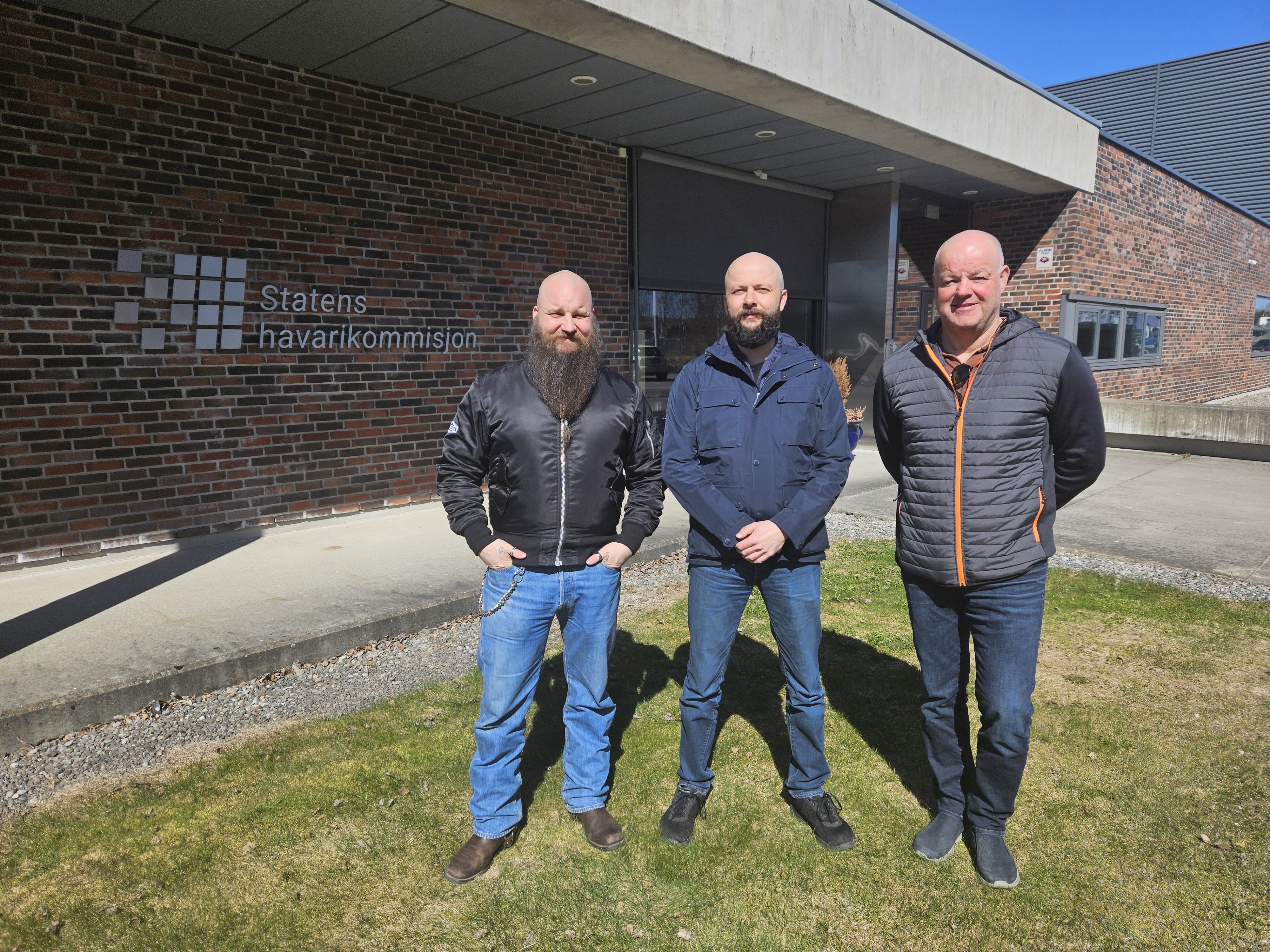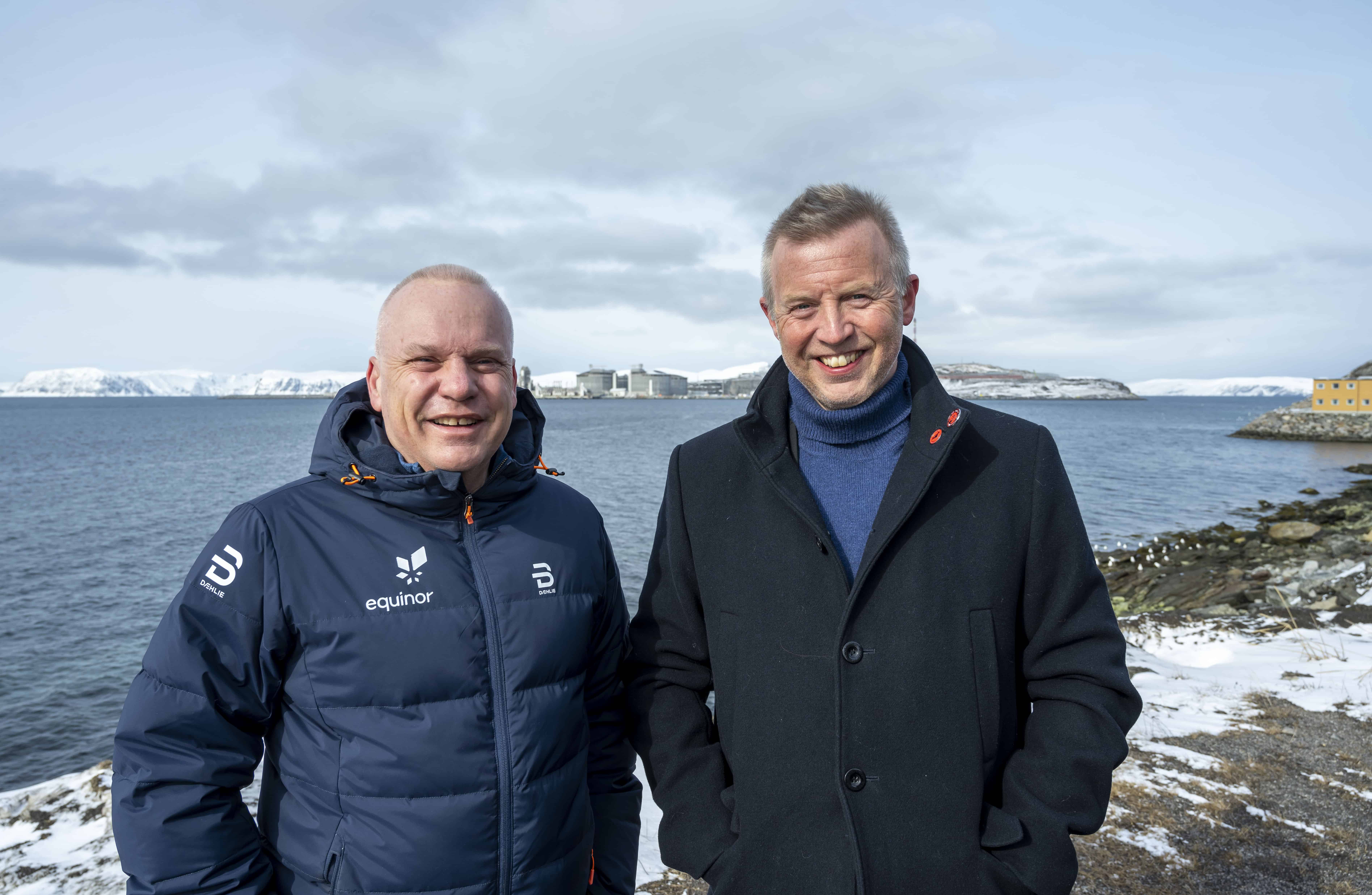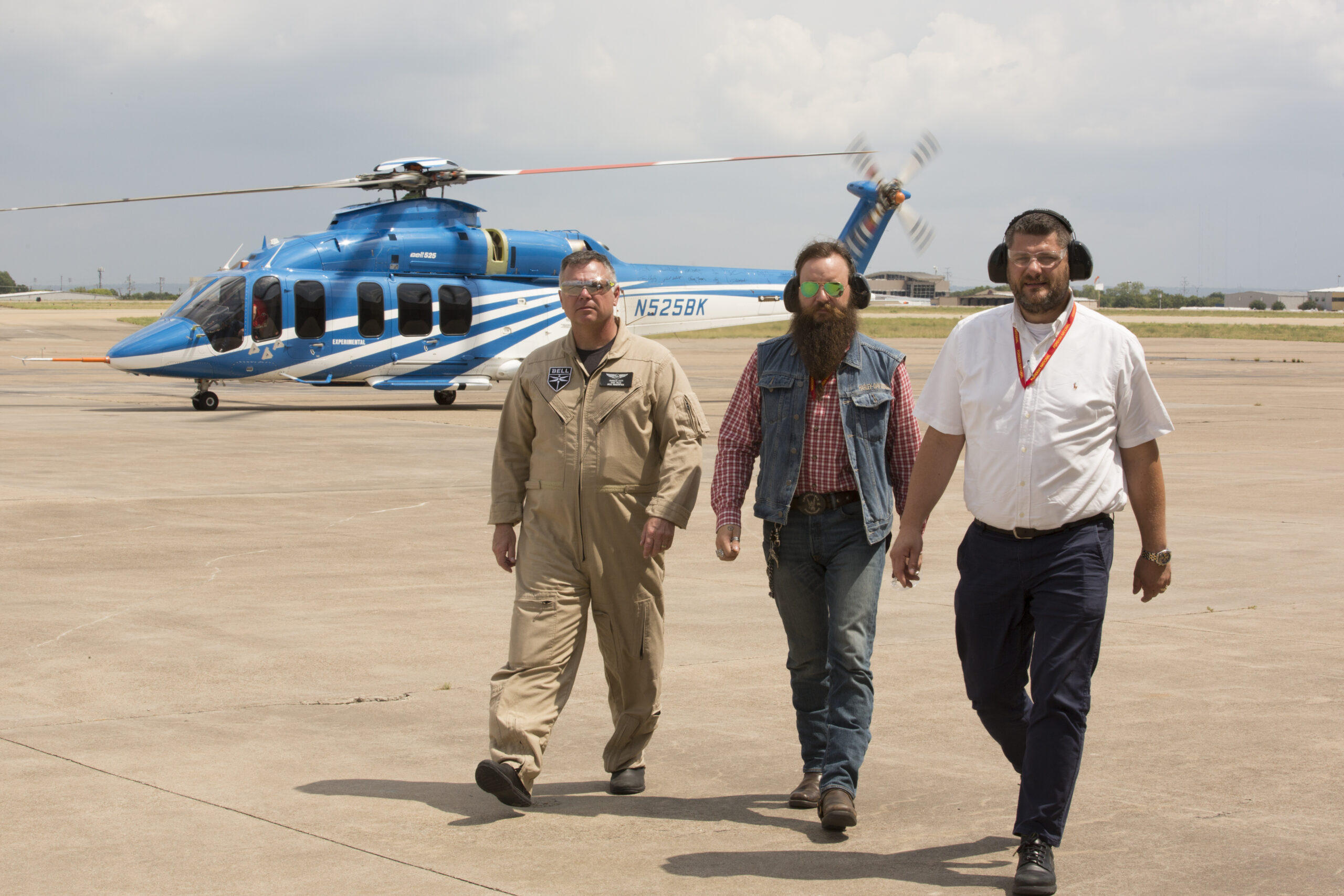
fredag 20. september 2019
LO’s Helicopter Committee went to Texas at the end of August to test-fly the newly developed offshore helicopter Bell 525 Relentless. “We are happy to be among the very first to fly this machine because it gives us a unique opportunity to contribute,” says Henrik S. Fjeldsbø, head of the Helicopter Committee.
Beneath the burning sun and with 40 degrees in the shade, nine representatives from the LOs Helicopter Committee are guided out to the tarmac at Bell’s Flight Research Center in Arlington, south of Dallas, USA. A light-blue and white painted Bell 525 Relentless stands there, all tanked up and ready. The helicopter is a test-machine, newly developed and not yet certified by the aviation authorities.
The representatives of the Helicopter Committee are among the first ever to fly the Bell 525.
Michael Hougaard, member of the Helicopter Committee and a daily S92 pilot in the North Sea, sits down in the machine’s left seat, while a test-pilot from the Bell takes the captains seat to the right. Two of the committee members get to sit on seats right behind the pilots.
The pilots go through the checklist, receives the clearance from the tower and start the engines. The five rotor-blades begin to swirl, first slowly, then faster and faster.
Fast Flying Machine
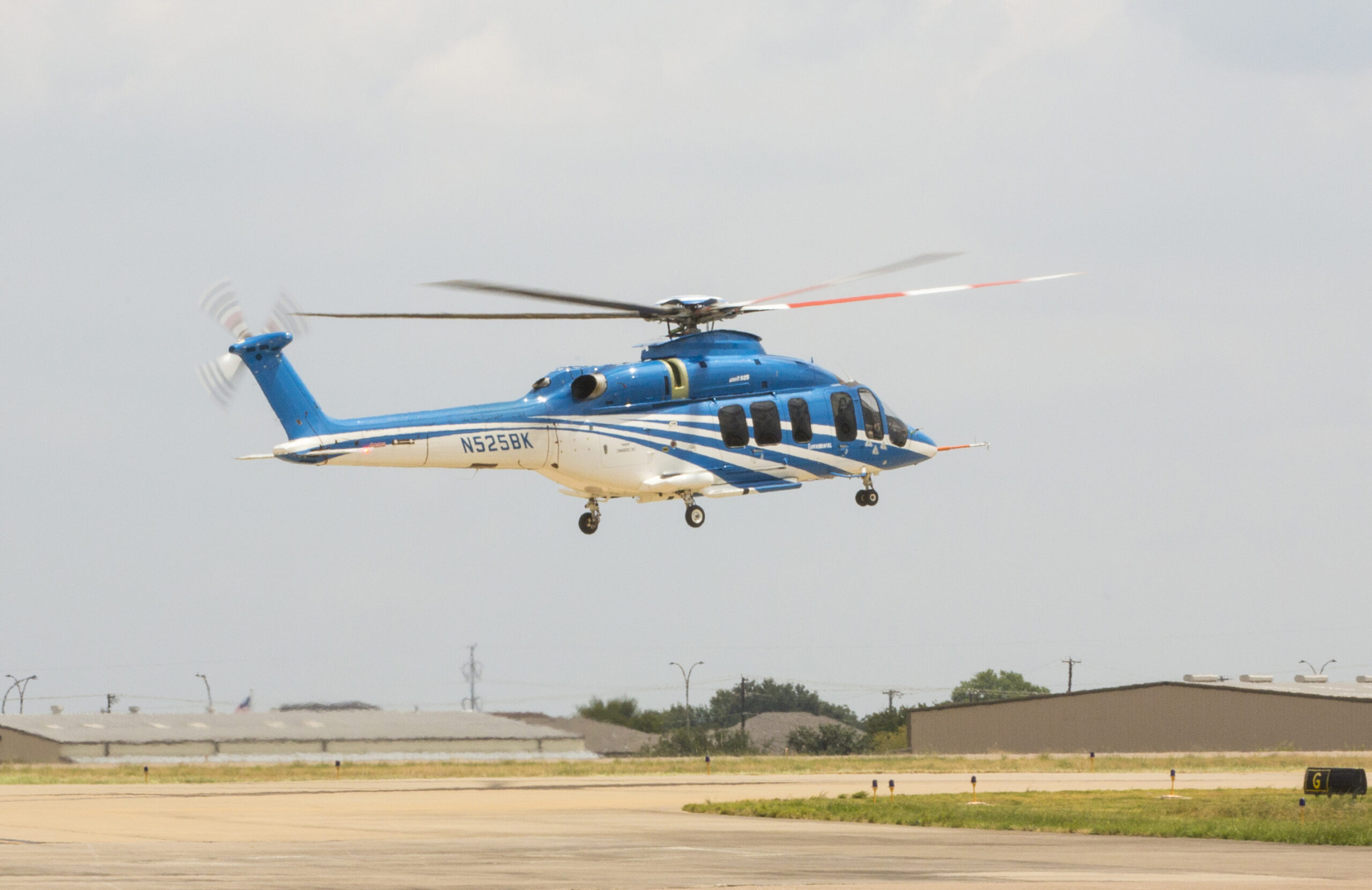
The American test-pilot taxi the machine down the runway before Michael takes over the controls and lifts it, so it hovers just 15 feet above the ground. He presses two buttons on the stick and the collective so that the helicopter can hover by itself.
The pilots check that everything is working as it should, then the nose tilts downwards and the speed increases, before the machine rises to 1500 feet, about 500 meters of altitude. We head towards a training area to the south, and on the way, we pass over vast agricultural areas, small towns and scattered houses. The view from the cabin is impeccable with huge windows on the sides and excellent visibility ahead. The speed increases to 165 knots, significantly faster than the other helicopters on the offshore shelf can manage today. Despite the high speed and the fact that the helicopter is a test machine, with one blade intentionally unbalanced, it flies soft with low vibration and relatively little noise.
Michael slows down and turns the machine to the left, before he lets go of the sticks. Nevertheless, the machine continues to turn until the pilot again grabs the controls and straightens it up. After a series of various manoeuvres, he points the nose back towards Arlington.
After four trips like these, the pilot Michael Hougaard is delightfully pleased. – The helicopter is unusually comfortable to fly. There are just about no vibrations, and the automatics, combined with the so-called fly-by-wire system, ensure its «smooth» to operate. It’s an incredibly smart helicopter that reduces the chance of the pilot making mistakes, while at the same time feeling extremely comfortable, he says.
Hougaard is clear on the fact that Bell 525 is a technological step forward.
“Amazingly, the machine predicts what the pilot wants to do. This allows me as a pilot to focus on keeping a clear view, which is crucial to safety”, he says.
Next Generation Technology

The helicopter pilot Torstein Sandven didn’t get to fly the machine himself, because of some trouble with the paperwork from the US Federal Aviation Administration (FAA). However, he got to test the machine in a full-flight Level D simulator and followed the flight from the cabin.
“Bell 525 will be an excellent platform to bring us forward to the next generation of helicopter technology. We welcome all new technologies that contribute to increased safety. I have big expectations to the machine, he says, while emphasizing that the machine is built to do things by itself.
The innovative technology removes some of the workload from the pilots and gives us increased situational awareness. I think it will be a very good machine, in regards to performing safe operations in the North Sea, when we have everything we want in place,” says Sandven.
Controlled by electrical signals
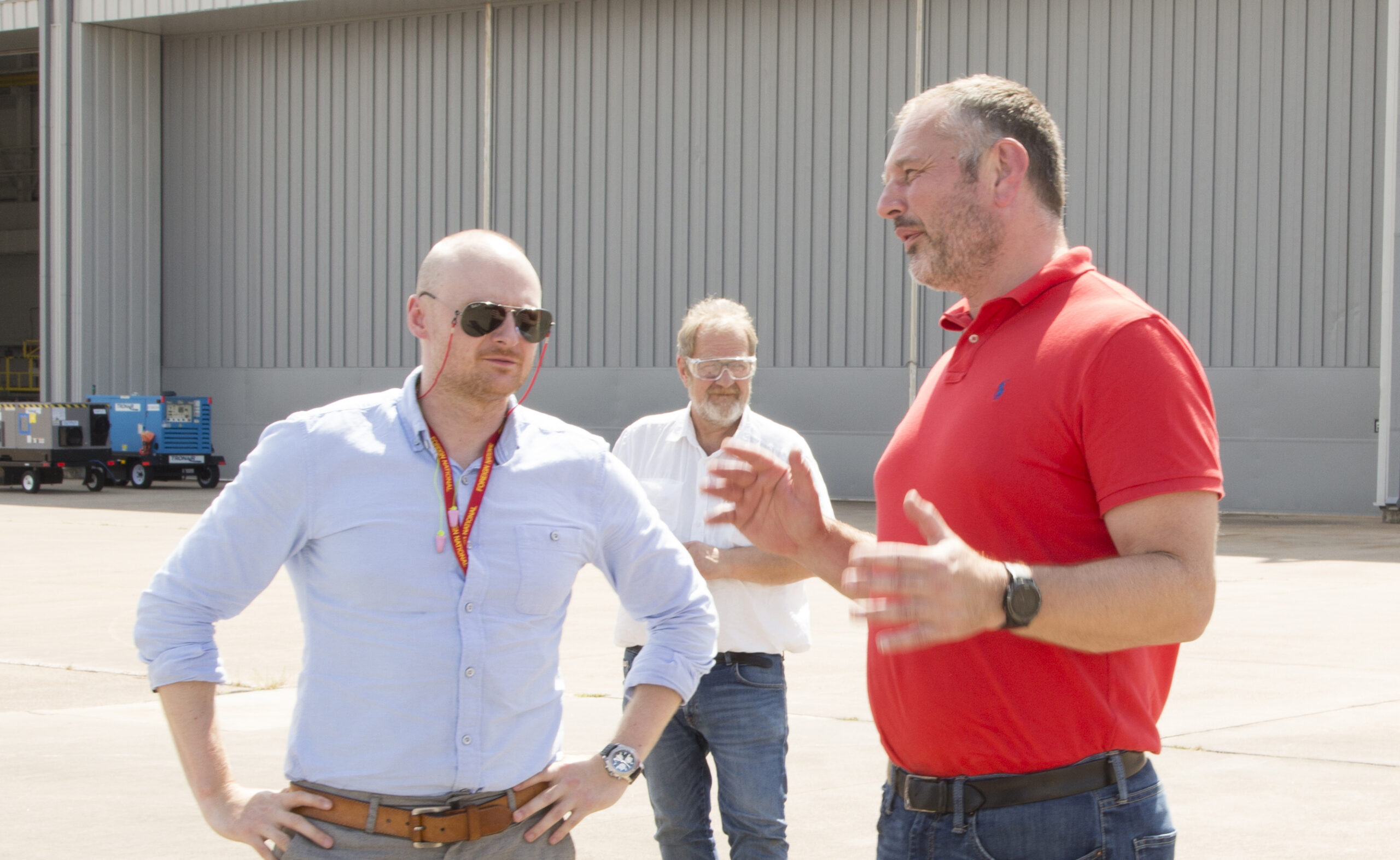
Bell 525 Relentless is a newly developed medium-sized helicopter that accommodates 16 offshore workers. It is referred to as a «Clean Sheet Design», meaning that the helicopter is designed from scratch. The helicopter is equipped with a so-called fly-by-wire system, a system that replaces conventional manual controls with electrical signals.
Tom Stian Beitland is a helicopter technician and a representative on the committee. He explains that due to the fly-by-wire technology, the helicopter is controlled by the electrical signals that go from the pilot’s controls, via a computer, to the rotors and disk area. It provides improved performance and increased stability, compared to conventional systems.
The technology has been in use on fighter airplanes and large passenger planes for decades already, but 525 is the first civilian helicopter with fly-by-wire.
Beitland emphasizes that Bell 525 is a robust machine and technically speaking, it’s intuitively built. The gearbox is sturdy and suspended with attachment schemes in oil-filled bearings, which provides reduced vibrations. The gearbox has excellent dry run characteristics, and it has been tested without oil for over an hour, without any problems.
“Technically speaking, the cockpit provides access to a lot of useful information, and it is easy to manoeuvre the systems manufactured by Garmin. The cockpit is orderly with relatively few switches. The only thing you´ll find in the roof is a rotor brake lever,” he says.
The helicopter’s online HUMS system (or IVHM – Integrated Vehicle Health Management, as Bell chose to call the system) is designed to provide real-time information to the land organization in certain situations, for example, if anything abnormal occurs.
Beitland is also impressed by the maintenance manual that has been digitized and developed with 3D drawings.
“In short, this means that the entire machine was built in 3D and linked with the maintenance manual. It makes it easier for us technicians to find components and procedures. It will contribute to increased efficiency in regards to troubleshooting, should any problems arise,” he says.
Tested the cabin and the seats
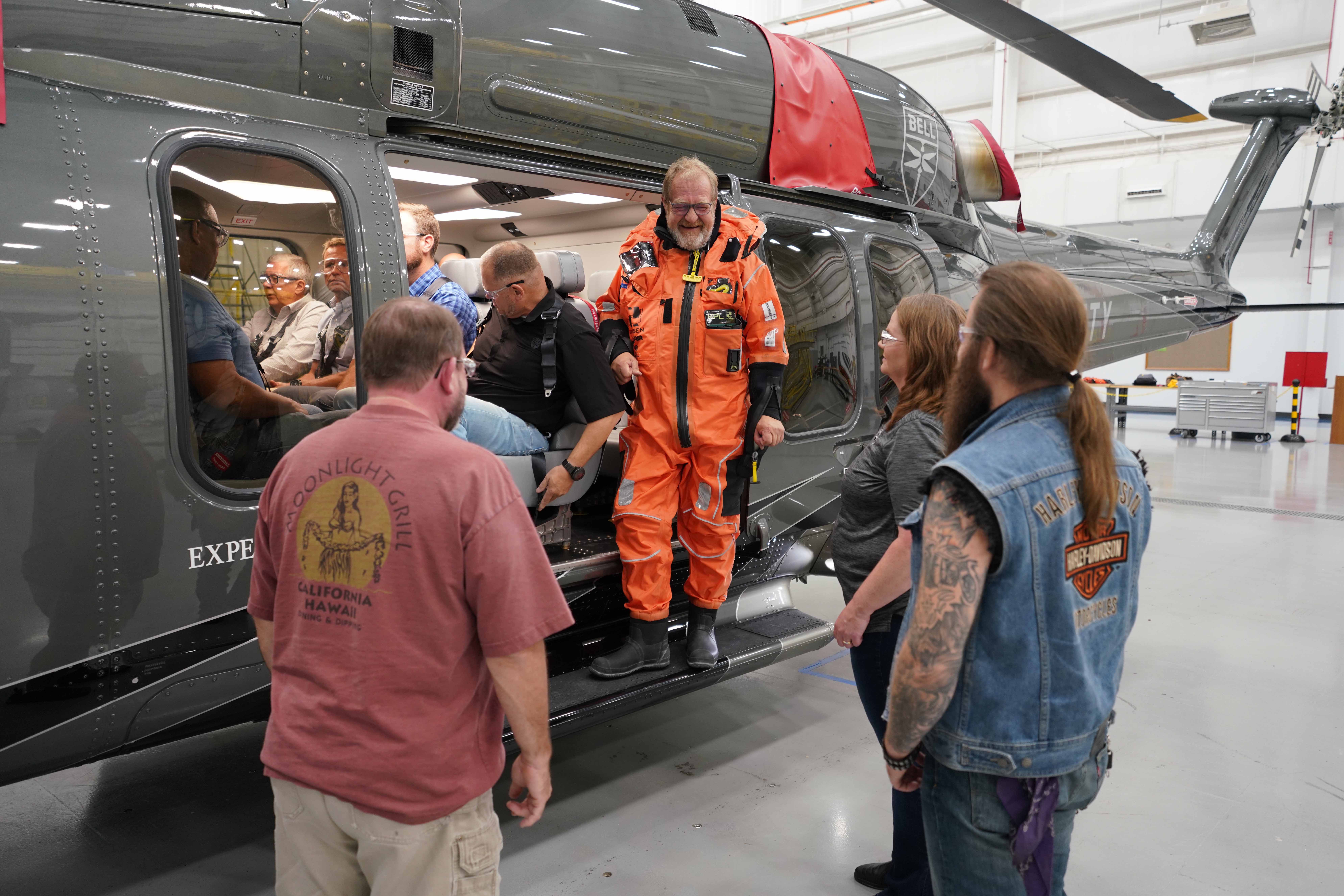
Last fall, the Helicopter Committee visited the production line in Amarillo where Bell’s 525 helicopters are assembled. This year, the committee was among the first to test-fly the machine, along with representatives from Bristow, Babcock and Equinor. The delegation also got a closer look at a 525 equipped in the way Bell envisions it as offshore helicopter transport, with 16 passenger seats, distributed over four-seat rows.
One of the committee members, Frode Nirisen, coordinating senior safety delegate in ConocoPhillips, wore a Norwegian survival suit to test the seats as realistically as possible.
“Even though the ceiling is quite low, the cabin appears to be light and airy. Its got large windows, which is vital in case of possible evacuation, but also in terms of perceived safety. The seats are wide, well-padded and very comfortable compared to the seats on today’s offshore machines,” says Nirisen.
He points out that four passengers in width will be a new experience for many. – At the same time, the space between the seats is so wide that it doesn’t feel cramped,» he says. He also points out that the manufacturer got feedback on how the seatback should be adjusted to be better accommodate passengers with Norwegian survival suits.
During the fall, Bell will perform a series of noise tests both in the cabin and outside. Frode Nirisen is eager to get the results and emphasizes that noise maps must be created around the machine for those who work on the helicopter deck offshore.
Filled the cabin with as many people as possible
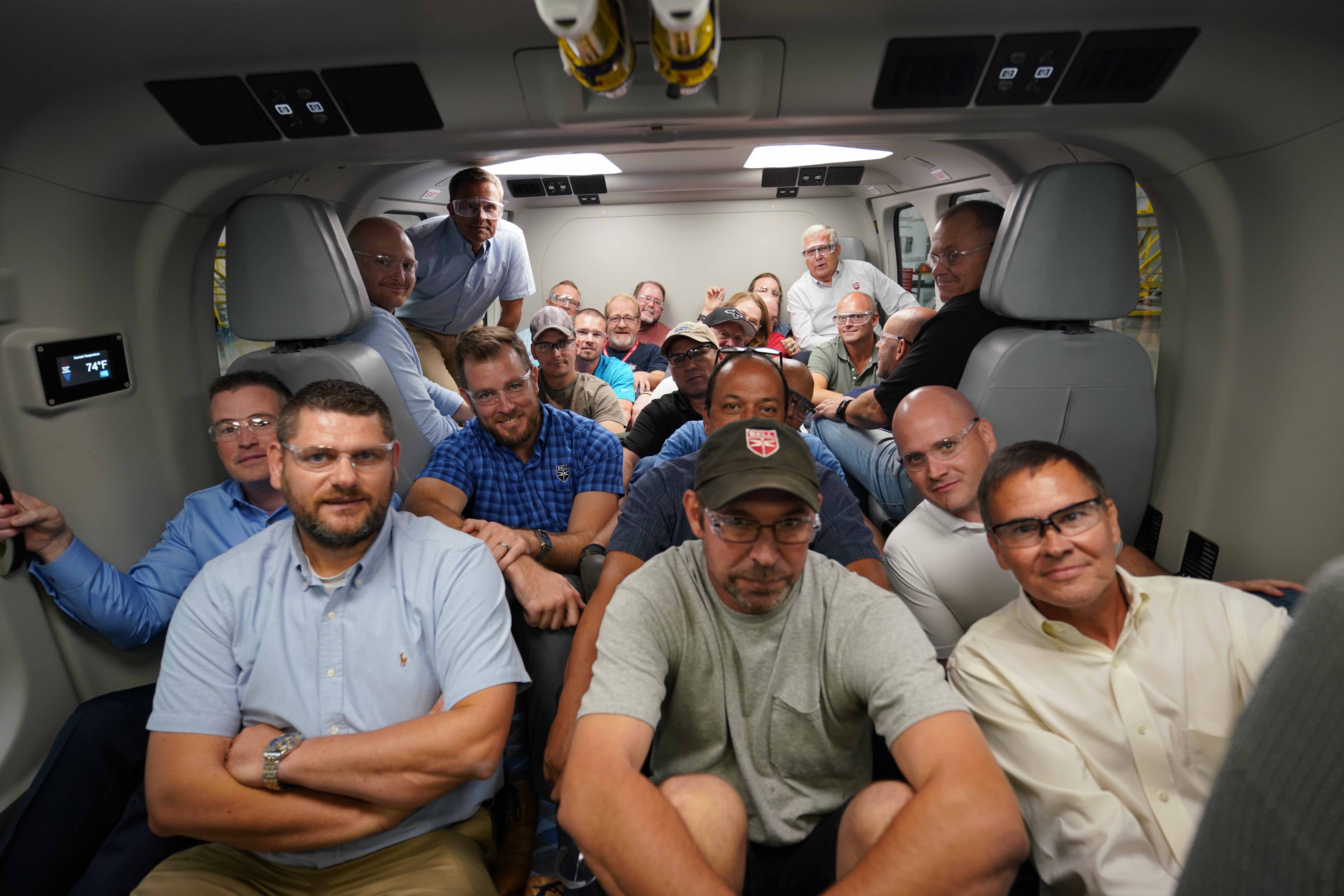
After a thorough check of seats, emergency exits, luggage compartments and more, the committee members asked if they could test whether the machine could be used as an offshore Search and Rescue Helicopter (SAR). All seats were removed and 23 people, both people from the committee as well as a number of Bell´s staff members, were crammed close together on the floor.
Kjetil Larsen, who is a rescue swimmer on a North Sea SAR helicopter, says its crucial to check whether the cabin is large enough to be used as a rescue helicopter offshore.
“We filled the cabin with as many people we could get hold of. We managed to accommodate 23 people on board comfortably, and yet there was room for a few more. That means the machine passed the test of being able to save 21” he says.
The committee has also provided a great deal of technical feedback to Bell on how they should design different solutions in regards to a possible search and rescue machine. – We know that Bell is still in the early planning stage for the SAR configuration of the helicopter, so they listened eagerly to our experiences and input,» says Larsen.
The North Sea is important for Bell
Bell and Tru Simulation&Training’s representative in Norway, Ole Petter Bakken, is proud that the Helicopter Committee’s members were among the first to fly the Bell 525, and test the cabin.
“None other than Bell’s own test pilots have flown the machine as much as Michael Hougaard. The feedback Bell got from the committee’s pilots, and the other representatives are very valuable for us, as we consider the North Sea as a priority area for the machine,» he says.
Bakken expects the machine to be certified by the US and European authorities in 2020/21, and that it will be ready for the Norwegian offshore market with full deicing equipment by 2022/23.
Unique oportunity to influence
Chairman of the LOs Helicopter Committee and national officer in Industri Energi, Henrik Solvorn Fjeldsbø, refers to the delegation trip to Bell, Texas, as both useful and educational.
“It was a positive experience, both with regard to checking out the cabin, getting more news on the status of the certification process, further plans and last, but not least, to fly the machine,” says Fjeldsbø.
He emphasizes how important it is for the Helicopter Committee to experience new helicopters in the air at an early stage, with the committee’s own pilots in the cockpit and as passengers in the cabin, so they may provide feedback before the helicopter gets certified.
“It gives us a unique opportunity to influence how the helicopter finally turns out and thus ensuring our members’ safety, while also considering the comfort level for the passengers and pilots.”
He emphasizes that the 525 machine that the committee flew is a test machine, loaded with test equipment, and not fully representative of how a transportation helicopter will be. “Nevertheless, we got a good idea of what the Bell 525 can do, and I expect the final product to be even better,” he says.
Useful meetings with management and union
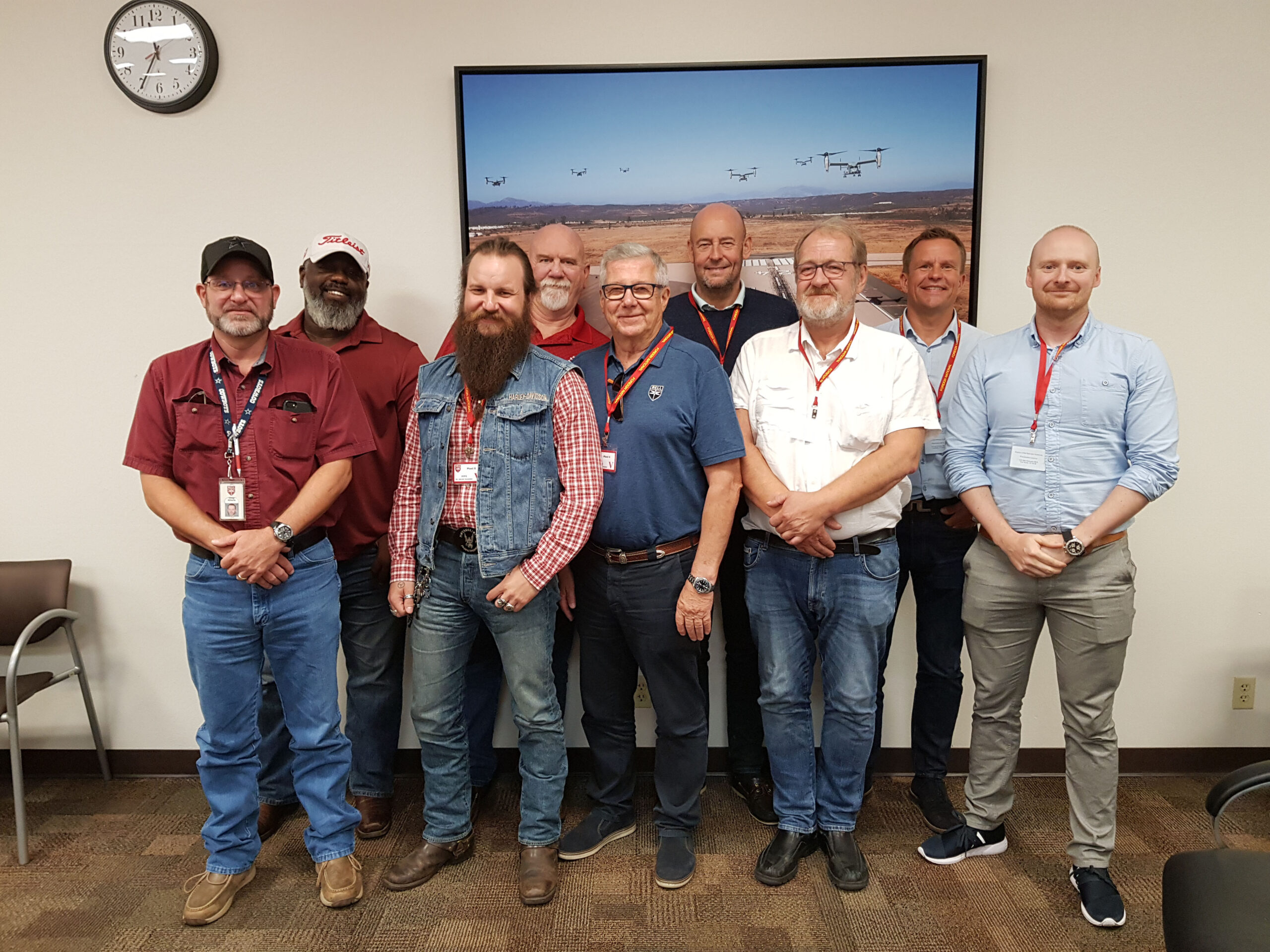
During the visit in Texas, the Helicopter Committee held meetings with the Bell Group CEO, Mitch Snyder, Program Director for the 525, Byron Ward, and union representatives Mark Upton, Greg Athens and Byron Maxfield, from the United Aerospace Workers (UAW) union.
“We discussed our impressions, working environment and the safety and quality philosophy of the company. It was particularly important for us to talk to the local trade union, as they have insight into what’s going on at the company, and to hear about any problems. It was reassuring to us to be able to engage in such a dialogue,” says Fjeldsbø.
“We also invited the American union representatives to come to Norway, to take part in our own helicopter seminar next spring, to be even more familiar with our union and its representatives, and thus to be able to build good relationships,” he adds.
More alternatives on the shelf wanted
“Ever since the Turøy accident in the spring of 2016, we’ve been broadly agreed in the Norwegian helicopter industry that we do not want the Airbus H225 Super Puma back in offshore traffic. We also prefer an organisation model with two helicopter types, as we always have had in the North Sea, as that means redundancy and more robustness,” explains Fjeldsbø.
He emphasises that the Helicopter Committee is keeping an eye on the market, and wants to acquire first-hand knowledge of all current machines.
“We can see that a helicopter in the ‘super-medium’ class can cope with many of the jobs the Airbus H225 used to do. And the committee has looked closer at several alternatives, such as the Airbus H175, Leonardo AW189 and now the Bell 525.
At the end of the day, it’s not us who decide which helicopter the operator companies will use, but we can influence product development and the people who buy the helicopters. And we will never accept being fobbed off with second-rate solutions,” he concludes.
